Chapter 4
Choosing the Right Crown
Aim
The aim of this chapter is to consider what factors are important when choosing the type of crown, and how to select the best materials to use.
Objective
After reading this chapter, the reader will be better able to judge which type of crown and what material should be used in a particular situation.
Introduction
There is an increasing range of crowns with a variety of physical properties. Crowns can, however, be conveniently classified into four main types:
-
metal (usually gold alloys)
-
metal-ceramic
-
all-ceramic
-
composite.
The clinician needs to weigh up the “pros” and “cons” of alternative crowns and advise the patient on the most suitable type for a given situation. This choice will be determined by general factors such as cost and preoperative factors, including the extent and type of existing restoration.
General Factors
Most patients want a tooth-coloured smile and would prefer not to show any metal restorations. Therefore, metal-ceramic and all-ceramic crowns are preferred for restoring teeth within the smile line. This has an impact upon cost and the amount of preparation required to successfully complete the crownwork. The results obtained with all-ceramic and metal-ceramic crowns can be excellent, but the end result is highly dependant upon the skill of the dental team. The clinician needs to complete a satisfactory preparation with sufficient horizontal and vertical space required to accommodate an aesthetically pleasing crown. In everyday practice the choice between different types of crown is often a question of the price the patient can afford to pay.
Preoperative Factors
Tooth Related Factors
Crowns are expensive; preoperative assessment of a tooth prior to considering a crown is therefore an important part of the decision making process. There are obvious assessments to make, such as vitality, periradicular status, quality of any root filling, inclination of the tooth and the occlusion. When deciding on the type of material for a crown, it is important to consider:
-
the size of the restoration
-
the core
-
the position of the margin
-
the vertical and horizontal space available
-
the occlusal load
-
the extent of tooth wear (Chapter 8)
-
availability of appropriate technical support (Fig 4-1 and Fig 4-2).

Fig 4-1 The fracture of the upper central incisor compromises the smile of this patient. The length and width of the restoration should mimic the adjacent teeth.
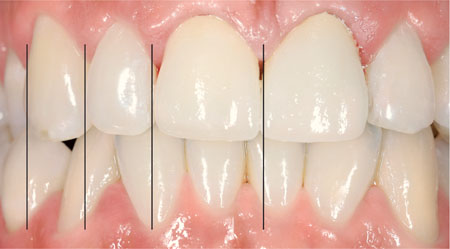
Fig 4-2 The restorations placed on the patient seen in Fig 4-1. The margins of the crown are at the gingival margin, and in some areas just into the gingival crevice. If the patient maintains good oral hygiene, drift of the margin will be limited. The vertical lines highlight the concept of the golden proportion. The width of the central incisor is dominant and the relative widths of the lateral incisor and canine are incrementally narrower.
The Size of Restoration
The performance and appearance of modern direct composite restorative materials is so good that there is no longer a pressing need to prepare extensively broken down teeth for crowns. The advantage of composite materials is that they can be repaired at the chair-side and maintained for long periods of time (Fig 4-3). The average survival for composites is 3–5 years and for crowns it is 10 years, but composites have the advantage of being more conservative of tooth tissue. Provided the repairs are not continuous and that there are reasonable time intervals of at least a year between appointments, composites can be maintained over many years. Once the maintenance periods reduce to every 3–6 months, the time and cost of repairing composites becomes uneconomical.
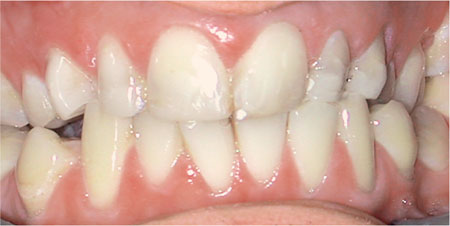
Fig 4-3 Composites have been placed along the incisal edges of these worn incisors and maintained for five years with annual refinishing. The appearance and translucency of modern composites provides aesthetically pleasing restorations which conserve tooth tissue.
The Margin
The optimal position for the gingival margin of a crown is on natural tooth just within the gingival sulcus (Fig 4-4). This hides the margin of the crown, limits plaque accumulation and offers the best opportunity of ideal marginal adaptation. This ideal situation can be difficult to achieve. Without an accurate impression of the margin, the longevity of the restoration will be compromised (Fig 4-5). A common dilemma is an extensively restored tooth needing a crown which has subgingival margins (Fig 4-6). A possible compromise is to finish the preparation for the crown on the core material and so provide a more favourable situation for the impression. Unfortunately, relying on two margins, one between the tooth and core and the other between the core and the crown, means an increased risk of early failure. In these circumstances, consideration should be given either to using an alternative to a crown, or to surgically repositioning the gingival margin apically to create a longer clinical crown.

Fig 4-4 Margins of a crown at or around the gingival margin will remain more stable than those which are placed subgingivally.
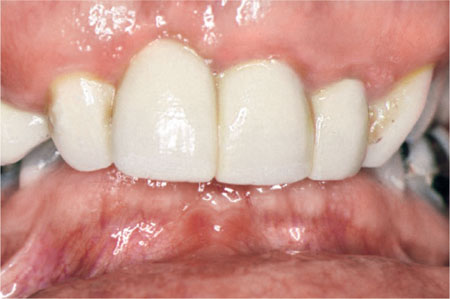
Fig 4-5 The margins on these anterior crowns have been placed subgingivally. The visible halo of the darkened gingival margin is apparent. If the patient is susceptible to periodontal disease the margin will continue to migrate apically eventually becoming exposed. This is a case in which crown lengthening should have preceded the provision of crowns.
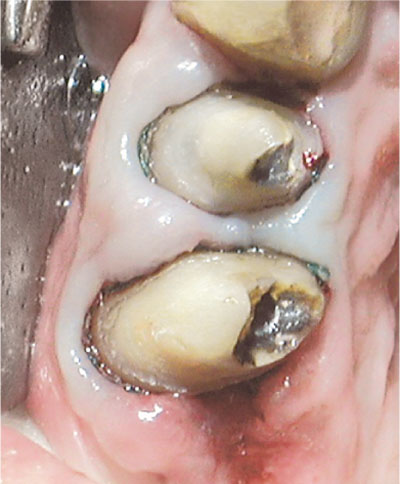
Fig 4-6 Teeth with subgingival margins are difficult to restore with crowns. Good soft tissue management can allow an acceptable impression to be taken. If the margins cannot be clearly recorded in an impression, either crown lengthening is indicated or a crown is contraindicated.
The periodontal health of the gingiva surrounding a crown will, in part, be dependent upon the emergence profile of the crown. A good profile should mimic the contour of the tooth prior to the restoration. The preparation should remove sufficient tooth to allow the technician to develop a favourable crown profile. Overbuilding the crown creates an unfavourable emergence profile, increasing the risk of plaque accumulation and making cleaning more difficult. Under-preparing teeth, although conservative of tooth tissue, may have other consequences for gingival health (Fig 4-7a,b).

Fig 4-7a These anterior crowns have been overbuilt because insufficient tooth was removed. Such overbuilt crowns make maintenance of oral hygiene difficult.
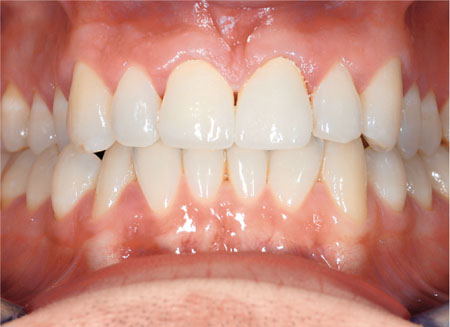
Fig 4-7b The emergence profile of these crowns is in harmony with the adjacent teeth, giving a pleasing result. There is, however, a small black triangle between the two central incisors. Increasing the width of the teeth to hide the triangle would increase the contact area making the crown appear wider. The compromise of accepting a small black triangle was accepted.
The Core
Most teeth that are crowned will have an existing core restoration. The choice of a full or partial coverage crown, will have an impact upon the retention of the core. For example, crowns prepared on premolar and molar teeth with extensive amalgam MOD restorations present a particular problem.
Amalgams are classically retained by undercuts on the buccal and lingual walls. Crown preparation may remove the support and retention of the core (Fig 4-8). An alternative crown design such as a three-quarter or cuspal coverage overlay can overcome these difficulties (Fig 4-9). Alternatively, an all-ceramic inlay or onlay directly luted to the tooth with an adhesive cement may conserve the buccal and lingual walls (Fig 4-10). The common dilemma is whether to provide a full or partial coverage crown on an extensively restored posterior tooth. A partial coverage overlay may be preferable to a full coverage metal-ceramic crown, but patient preference, vertical and horizontal space and clinical crown height are also important issues to consider.
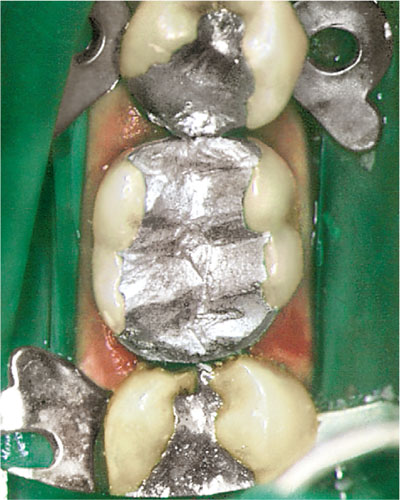
Fig 4-8 Removal of the buccal and lingual walls for a full coverage crown will result in loss of retention for the core. Preparation for a partial gold crown would retain walls which help retain and support the core.
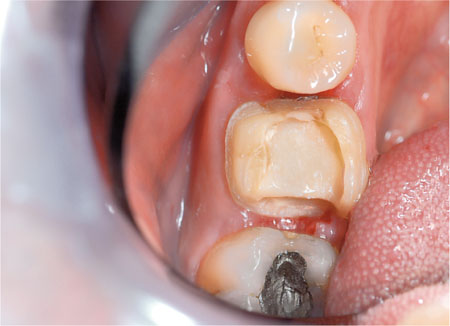
Fig 4-9 A three-quarter crown or cuspal coverage overlay conserves the lingual and buccal walls. The restoration can be made from porcelain, indirect composite or gold.
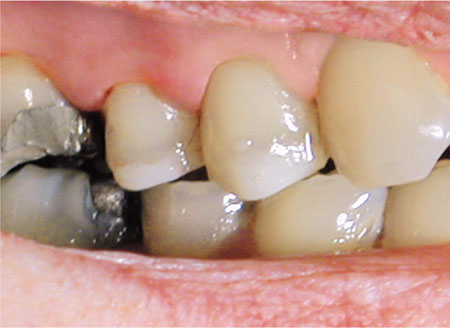
Fig 4-10 An extracoronal indirect composite has been used to restore the premolar teeth. Although the margins are visible, the design allowed the buccal wall to be retained to maintain the integrity of the core.
The situation with anterior teeth is somewhat different. Here the need is to provide good aesthetics while maximising preservation of tooth tissue. While preserving tooth tissue is important, a visible junction between porcelain and tooth in partial coverage overlays typically results in an unacceptable outcome.
Vertical Space
The occlusal reduction needed for a metal-ceramic crown is greater than that for a metal onlay. The space needed for metal-ceramic occlusal coverage is around 1.5 mm. For all-ceramic crowns the space needed is nearer 1.5–2 mm. This is to provide sufficient space for an adequate thickness of ceramic, the material being relatively weak in thin section. Providing a metal occlusal surface can conserve tooth tissue and be useful when vertical space is compromised. However, in the mandible the metal will show, in particular, on first molars and premolars. R/>
Stay updated, free dental videos. Join our Telegram channel

VIDEdental - Online dental courses


